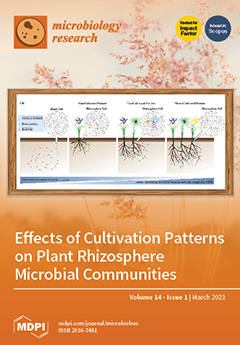The increasing production of industrial aromatic plant residues (IAPRs) are potentially environmental risky, and composting is a promising solution to resolve the coming IAPR problems. Carbon source degradation is a basic but important field in compost research; however, we still lack a clear understanding of carbon source degradation and the corresponding relationship to microbial community variation during IAPR composting, which hampers the improvement of IAPR composting efficiency and the promotion of this technology. In this study, samples were chosen on the first day, the 10th day, the 20th day, and the last day during the composting of
Cinnamomum camphora leaf IAPRs, and the microbial community composition, main carbon source composition, and several enzyme activities were measured accordingly. The results showed that during composting, the hemicellulose had the highest reduction (200 g kg
−1), followed by cellulose (143 g kg
−1), lignin (15.5 g kg
−1), starch (5.48 g kg
−1), and soluble sugar (0.56 g kg
−1), which supported that hemicellulose and cellulose were the main carbon source to microbes during composting. The relative abundance of the main bacterial phylum
Firmicute decreased from 85.1% to 40.3% while
Actinobactreia increased from 14.4% to 36.7%, and the relative abundance of main fungal class
Eurotiomycetes decreased from 60.9% to 19.6% while
Sordariomycetes increased from 16.9% to 69.7%. Though principal coordinates analysis found that both bacterial and fungal community composition significantly varied during composting (
p < 0.05), structure equation modeling (SEM) supported that bacterial composition rather than fungal counterpart was more responsible for the change in carbon source composition, as the standard total effects offered by bacterial composition (−0.768) was about five times the fungal composition (−0.144). Enzyme2 (comprised of xylanase, laccase, cellulase and manganese peroxidase) provided −0.801 standard total effects to carbon source composition, while Enzyme1 (comprised of lignin peroxidase and polyphenol oxidase) had only 0.172. Furthermore, xylanase and laccase were the only two enzymes appeared in co-occurrence network, clustered with nearly all the carbon sources concerned (except starch) in module-II. Xylanase, hemicellulose, and cellulose were linked to higher numbers of OTUs, more than laccase and other carbon sources. In addition, there were 11 BOTUs but only 1 FOTUs directly interacted to xylanase, hemicellulose, and cellulose simultaneously, three of them were
Limnochordaceae and two were
Savagea, which highlighted the potential core function in lignocellulose degradation provided by bacterial members, especially
Limnochordaceae and
Savagea. Thus, the results supported that during composting of
Cinnamomum camphora leaf IAPRs, the degradation of dominate carbon sources, hemicellulose and cellulose, was mainly driven by bacterial community rather than fungal community. In addition, the bacterial originated xylanase and laccase played potentially core roles in the functional modules. This research clearly investigated the microbial dynamics of carbon source degradation during the composting of
Cinnamomum camphora leaf IAPRs, and offers valuable information about and new insight into future IAPRs waste treatment.
Full article





